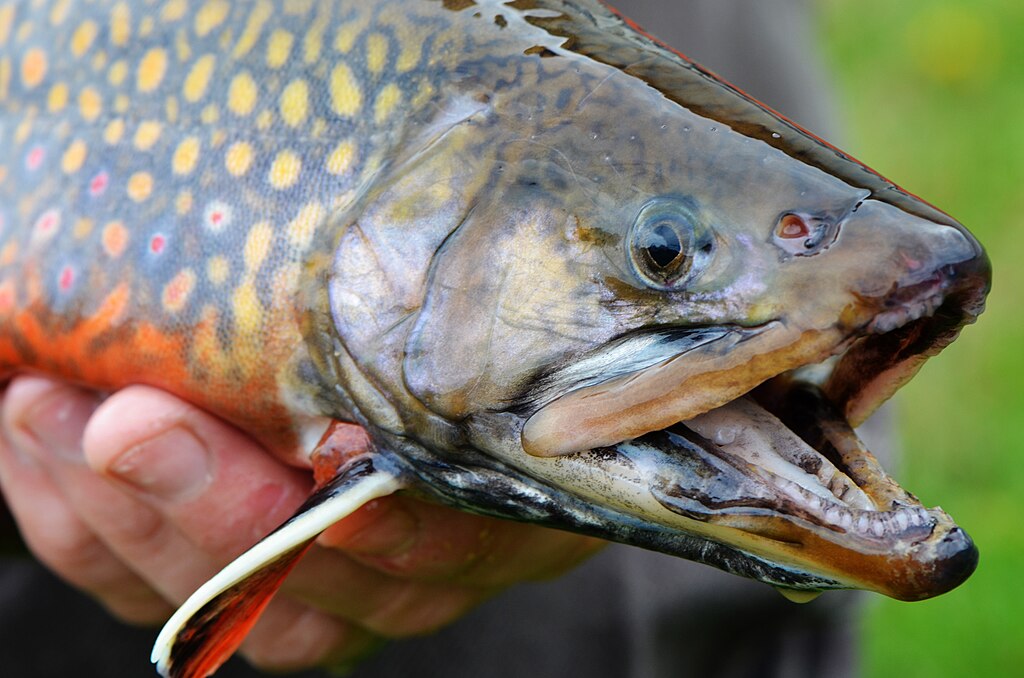
Brook Trout
Scientific Name: Salvelinus fontinalis
Also known as: Speckled Trout, Brookie, Mountain Trout
General Description
The Brook Trout is a native species to North America, prized by anglers for its striking beauty and elusive nature. With its vibrant coloring, ranging from green to blue with red and white markings along its fins and belly, the Brook Trout is easily recognizable. This species typically grows to about 10 to 15 inches but can reach up to 20 inches or more in ideal conditions. Its distinctive appearance, with speckled patterns and a white-edged fin, makes it one of the most sought-after fish in freshwater fishing.
Brook Trout are cold-water fish that thrive in clean, well-oxygenated streams and rivers. They are known for their agile, fast swimming and can be challenging to catch due to their wariness and preference for remote, pristine habitats. Unlike other trout species, Brook Trout have a preference for cooler temperatures, making them most active in the spring and fall months when water temperatures are optimal. They are opportunistic feeders, consuming a wide variety of aquatic insects, small fish, and crustaceans.
Their elusive nature and the beauty of their habitats make them a favorite among anglers seeking a more rustic and tranquil fishing experience. Whether in mountain streams or forested lakes, Brook Trout offer an exceptional fishing challenge.
Where to Find Them
Brook Trout are primarily found in the cool, clear waters of streams, rivers, and lakes, particularly in the northeastern United States, the Appalachian region, and parts of Canada. They are a freshwater species that prefer cold, well-oxygenated water, thriving in temperatures between 50°F and 60°F. Brook Trout are generally found in headwater streams and smaller, colder tributaries of larger rivers. They are often found in remote mountain streams, deep pools, and high-altitude lakes, particularly in areas where water quality is high.
In the U.S., Brook Trout populations are prevalent in states like Maine, Vermont, New Hampshire, Pennsylvania, and parts of the Great Lakes region. They are also present in cold-water rivers and lakes in parts of the Rocky Mountains and the Sierra Nevada. While wild Brook Trout populations are most commonly found in these areas, many states and provinces stock lakes and rivers with Brook Trout to maintain fishing opportunities.
During warmer months, Brook Trout tend to seek out cooler, deeper sections of rivers and lakes, retreating to these spots to avoid higher water temperatures. In lakes, they are typically found in the deeper, cooler areas during midday and in shallow waters near the shore during the early morning and evening hours. Anglers often target Brook Trout in remote, unspoiled habitats to increase their chances of success.
Best Baits
Live Bait Options
- Nightcrawlers
- Minnows (small, cold-water species)
- Crayfish
- Worms (earthworms, red worms)
Artificial Bait Options
- Dry flies (nymphs, mayflies, and caddisflies)
- Streamer flies (imitating minnows or smaller fish)
- Small spinners (silver or gold)
- Crankbaits (natural color patterns)
- Soft plastics (minnow or worm imitations)
Best Fishing Methods
Brook Trout are often found in fast-moving, cooler waters, making them ideal targets for anglers who enjoy challenging fishing conditions. Fly fishing is by far the most popular method used to catch Brook Trout. A lightweight fly rod, paired with small dry flies, nymphs, or streamers, is essential. Dry fly fishing is particularly effective during the spring and fall when insects are most active. Casting a well-placed fly over the water’s surface can entice Brook Trout to rise for a strike, especially during hatch periods.
In smaller streams and mountain rivers, casting small spinners or spoon lures can be effective, especially in deeper pools or behind submerged rocks. When fishing with artificial baits, opt for natural colors like silver, gold, or brown to imitate the insect and fish species the Brook Trout is likely to feed on. Trolling with small crankbaits can also work in lakes, where the fish tend to seek cooler, deeper waters during midday.
Live bait fishing, particularly with worms, nightcrawlers, or minnows, is effective when targeting Brook Trout in lakes or slow-moving rivers. A simple bobber rig or bottom fishing setup with live bait allows anglers to target deeper areas where these fish often reside. The best time to fish for Brook Trout is during the early morning or late evening, when water temperatures are cooler and the fish are more actively feeding.
Summary
Fishing for Brook Trout offers a unique and rewarding experience for anglers who enjoy the beauty and challenge of pursuing a cold-water species. Known for their stunning appearance, with vibrant colors and speckled markings, Brook Trout are often found in remote, clean mountain streams, rivers, and deep lakes. These fish prefer well-oxygenated, cool waters, making them particularly active during the spring and fall months when temperatures are optimal.
Fly fishing is the most effective method for catching Brook Trout, with dry flies and streamers being particularly successful in clear, fast-moving waters. Small spinners and crankbaits are also effective in lakes or deeper river pools. For those using live bait, worms, crayfish, and minnows can attract these wary fish.
Brook Trout are known for being selective feeders, which adds to their challenge and appeal. Whether targeting them in wild mountain streams or stocked lakes, they offer a rewarding challenge for any angler. The remote, often pristine environments in which they live only add to the experience, making Brook Trout a favorite among anglers seeking both adventure and a connection with nature.


